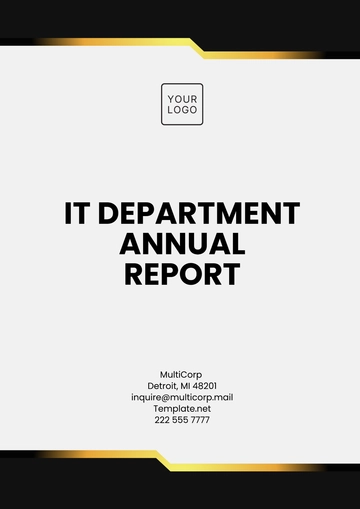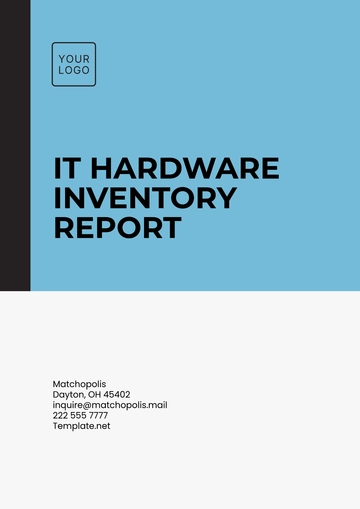Free IT Compliance Report

Date: December 16, 2050
Prepared by: [Your Name], IT Compliance Officer
Prepared for: [Your Company Name]
I. Introduction
This IT Compliance Report provides a detailed overview of the current state of IT compliance within [Your Company Name]. It assesses adherence to relevant regulations, standards, and internal policies to ensure the security, confidentiality, and integrity of the organization’s information systems. The findings presented in this report are based on the analysis conducted over the past six months and provide a snapshot of compliance status as of December 2050.
II. Scope of the Report
This report covers the following key compliance areas:
Data Security and Privacy
Regulatory Compliance
Risk Management
IT Governance
Internal Policies and Procedures
The assessment includes an evaluation of applicable industry regulations such as GDPR, HIPAA, and PCI-DSS, as well as internal IT policies and controls.
III. Compliance Framework and Methodology
The compliance review follows a comprehensive methodology that includes:
Documentation Review: Analyzing internal policies, procedures, and documentation to ensure alignment with regulatory requirements.
Interviews and Discussions: Engaging key stakeholders in discussions to gather insights on compliance practices.
System and Controls Assessment: Conducting system audits to ensure technical controls are in place and functioning as intended.
Risk Assessment: Identifying and evaluating potential risks to IT compliance.
This approach ensures a holistic view of the organization’s IT compliance status and areas for improvement.
IV. Findings
A. Data Security and Privacy
Compliance Status: Compliant
Details: [Your Company Name] has implemented strong encryption protocols for data at rest and in transit. However, there is a need to further strengthen access controls on certain sensitive systems, which are currently based on outdated multi-factor authentication methods.
Recommendations: It is recommended to implement more robust, modern multi-factor authentication protocols, such as biometric verification, across all systems handling sensitive data.
B. Regulatory Compliance
Compliance Status: Compliant
Details: The organization adheres to GDPR, HIPAA, and PCI-DSS, with policies in place for data privacy, reporting, and audit. However, some minor non-compliance issues were observed about data retention policies for certain non-critical systems.
Recommendations: A review of the data retention policy for non-critical systems should be undertaken to ensure full alignment with GDPR guidelines.
C. Risk Management
Compliance Status: Non-Compliant
Details: [Your Company Name] has a risk management framework in place, with regular assessments conducted to identify and mitigate potential risks. However, certain high-risk systems, such as legacy software and outdated server infrastructure, were identified as having inadequate security measures in place.
Recommendations: It is advisable to implement additional risk mitigation strategies for high-risk systems, including upgrading legacy systems and increasing network segmentation.
D. IT Governance
Compliance Status: Compliant
Details: The organization follows industry-standard governance practices, such as periodic audits and management reviews of IT policies. However, the lack of clear ownership for some key IT policies was noted, which can lead to inconsistencies in policy enforcement.
Recommendations: Strengthening policy ownership and ensuring that each policy has a designated responsible party will improve overall IT governance and compliance.
E. Internal Policies and Procedures
Compliance Status: Non-Compliant
Details: The internal policies for data handling, employee access, and data retention are generally well-maintained. However, several policies are outdated, particularly concerning cloud storage and remote work practices.
Recommendations: Policies should be updated to reflect current technological practices and regulatory changes, particularly in relation to the use of cloud services and remote work arrangements.
V. Conclusion
Overall, [Your Company Name] demonstrates a strong commitment to IT compliance, with substantial efforts made to ensure adherence to key regulations and internal policies. However, some areas require improvement, particularly in risk management and policy updates. By addressing the identified gaps, the organization can further enhance its compliance posture and reduce potential risks.
VI. Action Plan
The following action plan is proposed to address the identified gaps and strengthen IT compliance:
Short-Term Actions:
Implement modern multi-factor authentication across sensitive systems (by March 2051).
Update data retention policy for non-critical systems to align with GDPR (by January 2051).
Long-Term Actions:
Upgrade legacy systems and improve network segmentation (by June 2051).
Revise internal policies to reflect cloud storage and remote work practices (by May 2051).
Responsible Parties:
IT Security Team: Implement multi-factor authentication and upgrade legacy systems.
Compliance Officer: Review and update policies for GDPR compliance and internal procedures.
Deadline:
Short-Term Actions: March 2051 and January 2051.
Long-Term Actions: May 2051 and June 2051.
VII. Appendices
Appendix A: List of Regulations and Standards Reviewed (GDPR, HIPAA, PCI-DSS)
Appendix B: Detailed Risk Assessment Results
Appendix C: Policy Review Checklist
- 100% Customizable, free editor
- Access 1 Million+ Templates, photo’s & graphics
- Download or share as a template
- Click and replace photos, graphics, text, backgrounds
- Resize, crop, AI write & more
- Access advanced editor
You may also like
- Sales Report
- Daily Report
- Project Report
- Business Report
- Weekly Report
- Incident Report
- Annual Report
- Report Layout
- Report Design
- Progress Report
- Marketing Report
- Company Report
- Monthly Report
- Audit Report
- Status Report
- School Report
- Reports Hr
- Management Report
- Project Status Report
- Handover Report
- Health And Safety Report
- Restaurant Report
- Construction Report
- Research Report
- Evaluation Report
- Investigation Report
- Employee Report
- Advertising Report
- Weekly Status Report
- Project Management Report
- Finance Report
- Service Report
- Technical Report
- Meeting Report
- Quarterly Report
- Inspection Report
- Medical Report
- Test Report
- Summary Report
- Inventory Report
- Valuation Report
- Operations Report
- Payroll Report
- Training Report
- Job Report
- Case Report
- Performance Report
- Board Report
- Internal Audit Report
- Student Report
- Monthly Management Report
- Small Business Report
- Accident Report
- Call Center Report
- Activity Report
- IT and Software Report
- Internship Report
- Visit Report
- Product Report
- Book Report
- Property Report
- Recruitment Report
- University Report
- Event Report
- SEO Report
- Conference Report
- Narrative Report
- Nursing Home Report
- Preschool Report
- Call Report
- Customer Report
- Employee Incident Report
- Accomplishment Report
- Social Media Report
- Work From Home Report
- Security Report
- Damage Report
- Quality Report
- Internal Report
- Nurse Report
- Real Estate Report
- Hotel Report
- Equipment Report
- Credit Report
- Field Report
- Non Profit Report
- Maintenance Report
- News Report
- Survey Report
- Executive Report
- Law Firm Report
- Advertising Agency Report
- Interior Design Report
- Travel Agency Report
- Stock Report
- Salon Report
- Bug Report
- Workplace Report
- Action Report
- Investor Report
- Cleaning Services Report
- Consulting Report
- Freelancer Report
- Site Visit Report
- Trip Report
- Classroom Observation Report
- Vehicle Report
- Final Report
- Software Report



























